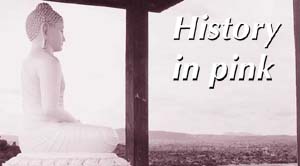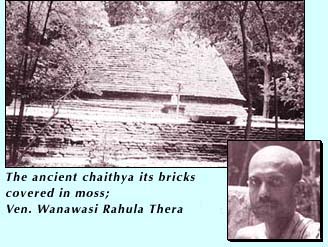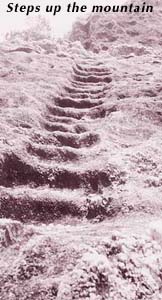 |
 25th October 1998 |
Front Page| |
History in pinkKumudini Hettiarachchi travels to the pink quartz mountain in the land of a lost civilisation Far from the madding crowd, there is a haven,
with cool breezes, natural springs and dense jungle. There is also a range
of seven hills, shimmering and sparkling in the sunlight. It is the National
Namal Park and the Pink Quartz Ridge tucked between the villages of Aandiyagala
and Madatugama in the North Central Province. As we approached Ulpathagama (village of springs) where the Namal Park is located, it was difficult to imagine that the rain-washed countryside was in the dry zone. There are two approaches to the Namal Uyana - on the Kalawewa Road through Galewela or on the Dambulla-Kekirawa Road through Madatugama. The first will lead the traveller through Aandiyagala and the latter through Madatugama and Pubbogama to their destination. Whatever route one takes, the Namal Park is off the beaten track. We took the straight red gravel road from Aandiyagala. Tiny wattle-and-daub huts were sparsely scattered. There was thick jungle in some places, shrubs in others and tall grass edging the dusty route. An old man who hitched a ride with us, said elephants roamed the area in the night. People eked out a living by cultivating paddy, onion and chillie. As we approached the turn-off to the Namal Park, a big board warned us of the "don'ts" inside - don't litter, don't break leaves, don't destroy the pink quartz rock, among other things. Enterprising villagers have put up five or six wooden huts selling soft drinks, fruits and vegetables. No vehicles can be taken into the park. As you walk along the sandy path with a web of old tree roots, nature awaits you in all its splendour. It's not just nature, as we found out, but also ruins of ancient temples and palaces. Who runs this park? A sole Buddhist monk, who on his own initiative has taken on the task of conserving the environment in the form of about 260 acres of Na, which is the national tree.
Last week in recognition of his efforts the Congress of Environmental Journalists honoured him with a Sri Lanka "Green Award." According to Ven. Rahula, in 1991 he was at the Ranala Temple, situated close to the Na forest, when he had a strange dream–God Kambili (venerated by the farmers in the area) appeared to him and told him to take over the guardianship of the forest. He found the forest and built a tiny hut on a mora tree and took up his task in March 1991. There were elephants and snakes, but no animal did him harm, only man. Many people did not like him being there because he was a hindrance to illicit felling and poaching. A powerful person even gave out a contract to kill him - but when the assailant shot at him the gun did not fire. That was due to the protection of God Kambili, the monk says humbly. Later he put up the avasaya. Near the hut is a tiny pool of water. There hung on a stick are plastic bottles, slippers and sili sili bags, with a big epa (don't) done in pebbles on a piece of wood, a short lesson in keeping the environment clean. Ven. Rahula says the park gets streams of visitors especially during the weekends and some of them create a lot of trouble-they shout, misbehave, break the trees and creepers and litter the place. This is not just a park, but a sacred Buddhist area, the monk explains, leading us to an ancient chaithya with the bricks covered in moss. Near it he shows us a moonstone (Sandakada Pahana) without intricate carvings. "The moonstone in Anuradhapura has intricate carvings of animals. So this must be from an earlier period," he says. Close by is also a large "gal pahana" (with a 90-cm radius). Carved on its ridge are eight slits for the wicks. Another interesting monument is the "bodhikaraya". Devotees would have been able to go through the two-pillar entrance, one at a time and only sideways, worship and leave from the exit also sideways. "When I came first, there was a large python inside the rock bowl. This must have been its home because of the coolness." Delving into history, the monk says that the park is believed to have been the largest open prison camp during the time of King Dappula IV in the 8th century. The punishment for those incarcerated must have been to plant the Na trees. At the foot of the pink quartz crag, he hands us over to agile and talkative 19-year-old Sisira Jayasundera, a lad from the village.
We come to a statue of the Samadhi Buddha, then head on, to the second statue on the peak. Sisira explains that these mountains are 600 million years old. After a steep climb, we are at the peak and I lean breathlessly on a pillar of the statue's shelter. The view is panoramic. A strong breeze blows past us. The Mahaindigollegama tank is hidden among the different shades of green forest cover. The distant hills are covered in a hazy blueness. Our knowledgeable 'guide,' in a sweeping gesture encompassing Kahalu Kanda, says, it is the longest mountain range in the country, stretching from the Kalawewa bund to Kurunegala's Athugala. As we slither down, Sisira says the pink quartz mountains are threatened by erosion. The rock hardens for the hot sun and cracks. Then the rain deepens the cracks and washes down the rubble. "The erosion has also caused a lessening of the pink hue of the rock," he says. Ven. Rahula says the park has certain distinctive features - it does not have a single bo-tree or fruit tree such as palu or veera though they are found in plenty beyond its perimetres. Seventy-two kinds of medicinal plants, 18 species of bird, and one of 14 rare species of lizard have been found within the park. About 50 yards from the entrance, Ven. Rahula has built a small house with three rooms, with funding from several local donors, to rent to 'good' people who visit the park if they wish to spend the night. The Pradeshiya Sabha has demarcated a car park and charges Rs. 20 per vehicle, but it has not provided the basic facilities like water and toilets to park visitors, the monk laments. He has set up the National Namal Park Development Foundation headed by Social Services Minister Berty Premalal Dissanayake, who is also an MP in the Anuradhapura district to carry on his good work. But he has a personal vision - to get the park declared a national heritage and persuade those in power to set up an environmental study centre at the spot. The park is already on the Internet and can be reached on e-mail: http://www.lanka.net/NNP. |
||
 |
More Plus * A heritage transformed
Front Page| News/Comment| Editorial/Opinion| Business| Sports | Mirror Magazine |
|
 |
Please send your comments and suggestions on this web site to |
|

 In
a tiny space surrounded by large and ancient trees, Ven. Wanawasi Rahula
Thera has built himself a tiny avasaya (hermitage), where he co-exists
with nature. But he has undertaken an onerous task - to protect the Na
forest, which also has valuable timber such as kaluwara and milla, against
illict fellers, the wildlife from poachers and the ancient ruins from treasure
hunters.
In
a tiny space surrounded by large and ancient trees, Ven. Wanawasi Rahula
Thera has built himself a tiny avasaya (hermitage), where he co-exists
with nature. But he has undertaken an onerous task - to protect the Na
forest, which also has valuable timber such as kaluwara and milla, against
illict fellers, the wildlife from poachers and the ancient ruins from treasure
hunters. Guiding
us up the mountain, of light pink and white rock, watched by several monkeys,
he says that Shah Jehan is believed to have got some of the pink quartz
rocks ferried from here to India to build the Taj Mahal in memory of his
Queen.
Guiding
us up the mountain, of light pink and white rock, watched by several monkeys,
he says that Shah Jehan is believed to have got some of the pink quartz
rocks ferried from here to India to build the Taj Mahal in memory of his
Queen.